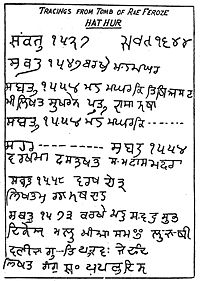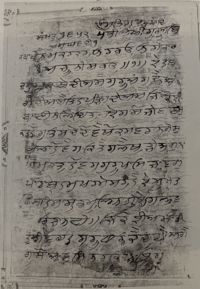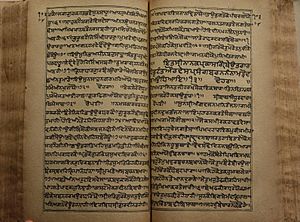Gurmukhi facts for kids
Quick facts for kids Gurmukhi script |
|
|---|---|
|
Modern Gurmukhi letters
|
|
| Type | Abugida |
| Spoken languages |
|
| Time period | 16th century CE-present |
| Parent systems | |
| Sister systems | Khudabadi, Khojki, Mahajani, Multani |
| Unicode range | U+0A00–U+0A7F |
| ISO 15924 | Guru |
|
The theorised Semitic origins of the Brahmi script are not universally agreed upon.
|
|
| Note: This page may contain IPA phonetic symbols in Unicode. | |
Gurmukhi (Punjabi: ਗੁਰਮੁਖੀ, Punjabi pronunciation: [ˈɡʊɾᵊmʊkʰiː], Shahmukhi: گُرمُکھی) is a special writing system used mostly in Punjab, India. It is also called Gurumukhi. This script is an abugida, which means its letters are mostly consonants, but they have a built-in vowel sound. You add small marks (diacritics) to change that vowel sound.
Gurmukhi was created from older Laṇḍā scripts. Guru Angad, the second Sikh Guru, helped make it standard around the 16th century. Many people see Gurmukhi as the script of the Sikhs. Punjabi Sikhs use it to write the Punjabi language. It is one of the official scripts in India. In Punjab, Pakistan, people use the Shahmukhi script, which is based on the Arabic script.
The main holy book of Sikhism, the Guru Granth Sahib, is written in Gurmukhi. It uses different dialects and languages, often called Sant Bhasha (saint language).
Modern Gurmukhi has 35 main letters. That's why it's sometimes called paintī, meaning "the thirty-five". It also has six extra consonants. Plus, there are nine vowel marks (diacritics) and other special marks for sounds.
Contents
How Gurmukhi Developed Over Time
The Gurmukhi script is thought to come from the Proto-Sinaitic alphabet. This happened through the Brahmi script. Brahmi then grew into many other scripts across India and Southeast Asia. Gurmukhi comes from the Sharada script, which was used in the northwestern part of India. Gurmukhi is the main script from that group still used widely today.
Gurmukhi developed in a unique way. It was created to write the holy texts of Sikhism. Sikh traditions were less focused on Sanskrit, which gave Gurmukhi freedom to develop its own special features.
Here are some cool things about Gurmukhi:
- It's an abugida. This means every consonant has a basic vowel sound, like "uh" ([ə]). Small marks change this sound.
- When a vowel starts a syllable, it uses its own special letter.
- To join consonants, Gurmukhi puts small letters below the main letters. Other scripts often merge parts of letters together.
- Punjabi is a tonal language. This means the pitch of your voice can change a word's meaning. Gurmukhi shows these tones using certain consonants.
From the 10th century, the Sharada script started to look different in various regions. In Punjab, the Sharada script changed a lot. By the 15th century, it had evolved so much that experts gave it a new name, Devāśeṣa. Some call this Pritham Gurmukhī, or Proto-Gurmukhi.
The Sikh gurus started using this early Gurmukhi to write the Guru Granth Sahib. Other scripts, like Takri, also came from Sharada. Takri was used in some hilly areas.
The Laṇḍā scripts were business scripts in Punjab. Laṇḍā means "without tail". This means they didn't have vowel symbols. There were many Laṇḍā scripts, and Mahajani was very popular. These were used for trade and daily life. But Gurmukhi made sure to use vowel marks. This made it much clearer and more accurate to read.
Over time, Gurmukhi became the main script for Sikh writings. It played a big role in the Sikh faith. It spread widely under the Sikh Empire. Sikh kings and chiefs used it for government work. It also helped make the Punjabi language stronger and more standard. For centuries, the first schools were often connected to gurdwaras (Sikh temples). These schools taught Gurmukhi.
The first Punjabi grammar books were written in Gurmukhi in the 1860s. Later, the Singh Sabha Movement in the late 1800s encouraged using Gurmukhi for newspapers and other media. After India became independent in the 1940s, and after the Punjabi Suba movement in the 1960s, Gurmukhi became the official state script of Punjab, India. Today, it is used everywhere: in culture, arts, education, and government.
What "Gurmukhi" Means
Many Punjabi language experts believe the name "Gurmukhi" comes from "Gurmukhs". These were followers who "faced" or "followed" the Guru. So, the script became known as Gurmukhi, meaning "the script of those guided by the Guru." Guru Angad is often given credit for creating and standardizing Gurmukhi. It is now the main script for Punjabi in India. The original Sikh holy books and most old Sikh writings are in Gurmukhi.
Some people translate Gurmukhi as "from the Mouth of the Guru." This idea might come from the script being used to write down the words of the Sikh Gurus. These words were called Gurmukhi. So, the script used to write them also got the same name.
The name for the Punjabi script used in Pakistan, Shahmukhi, was created based on the name Gurmukhi.
Gurmukhi Letters and Sounds
The Main Letters
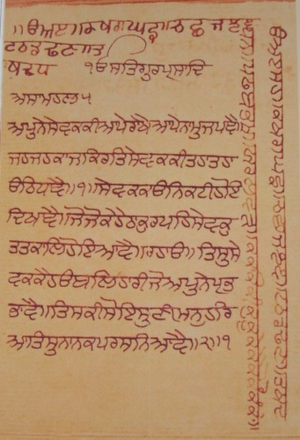
The Gurmukhi alphabet has 35 basic letters. They are usually arranged in seven rows of five letters. The first three letters are special. They are "vowel carriers" and form the base for vowels. They are not consonants like the rest.
The other letters are grouped by where their sound is made in the mouth. For example, sounds made at the back of the mouth (like 'k' and 'g') are in one group. The names of most consonants are based on their sound.
| Group Name (Where sound is made) ↓ |
Name | Sound [IPA] |
Name | Sound [IPA] |
Name | Sound [IPA] |
Name | Sound [IPA] |
Name | Sound [IPA] |
||||||
|---|---|---|---|---|---|---|---|---|---|---|---|---|---|---|---|---|
| Vowel Carriers (Vowels) |
Base Group (Fricatives) |
ੳ | ūṛā [uːɽaː] |
– | ਅ | aiṛā [ɛːɽaː] |
a [ə] |
ੲ | īṛī [iːɽiː] |
– | ਸ | sassā [səsːaː] |
sa [s] |
ਹ | hāhā [ɦaːɦaː] |
ha [ɦ] |
| Occlusives → | Soft | With breath | Voiced Stops | Tonal | Nasals | |||||||||||
| Velar Group (Velars) |
ਕ | kakkā [kəkːaː] |
ka [k] |
ਖ | khakkhā [kʰəkʰːaː] |
kha [kʰ] |
ਗ | gaggā [gəgːaː] |
ga [ɡ] |
ਘ | kàggā [kə̀gːaː] |
kà [ kə̀ ] |
ਙ | ṅaṅṅā [ŋəŋːaː] |
ṅa [ŋ] |
|
| Palatal Group (Affricates/Palatals) |
ਚ | caccā [t͡ʃət͡ʃːaː] |
ca [t͡ʃ] |
ਛ | chacchā [t͡ʃʰət͡ʃʰːaː] |
cha [t͡ʃʰ] |
ਜ | jajjā [d͡ʒəd͡ʒːaː] |
ja [d͡ʒ] |
ਝ | càjjā [t͡ʃə̀d͡ʒːaː] |
cà [ t͡ʃə̀ ] |
ਞ | ñaññā [ɲəɲːaː] |
ña [ɲ] |
|
| Retroflex Group (Retroflexes) |
ਟ | ṭaiṅkā [ʈɛŋkaː] |
ṭa [ʈ] |
ਠ | ṭhaṭṭhā [ʈʰəʈʰːaː] |
ṭha [ʈʰ] |
ਡ | ḍaḍḍā [ɖəɖːaː] |
ḍa [ɖ] |
ਢ | ṭàḍḍā [ʈə̀ɖːaː] |
ṭà [ ʈə̀ ] |
ਣ | nāṇā [naːɳaː] |
ṇa [ɳ] |
|
| Dental Group (Dentals) |
ਤ | tattā [t̪ət̪ːaː] |
ta [t̪] |
ਥ | thatthā [t̪ʰət̪ʰːaː] |
tha [t̪ʰ] |
ਦ | daddā [d̪əd̪ːaː] |
da [d̪] |
ਧ | tàddā [t̪ə̀d̪ːaː] |
tà [ t̪ə̀ ] |
ਨ | nannā [nənːaː] |
na [n] |
|
| Labial Group (Labials) |
ਪ | pappā [pəpːaː] |
pa [p] |
ਫ | phapphā [pʰəpʰːaː] |
pha [pʰ] |
ਬ | babbā [bəbːaː] |
ba [b] |
ਭ | pàbbā [pə̀bːaː] |
pà [ pə̀ ] |
ਮ | mammā [məmːaː] |
ma [m] |
|
| Approximants and liquids | ||||||||||||||||
| Ending Group (Sonorants) |
ਯ | yayyā [jəjːaː] |
ya [j] |
ਰ | rārā [ɾaːɾaː] |
ra [ɾ]~[r] |
ਲ | lallā [ləlːaː] |
la [l] |
ਵ | vāvā [ʋaːʋaː] |
va [ʋ]~[w] |
ੜ | ṛāṛā [ɽaːɽaː] |
ṛa [ɽ] |
|
Some nasal letters are not used as much anymore. The sounds they make often appear as variations of the 'n' sound. The letter ਵ can sound like 'v' or 'w' depending on the vowel next to it.
Punjabi has a special tone system. Gurmukhi doesn't have separate symbols for tones. Instead, certain consonants show the tone. For example, ਘ, ਝ, ਢ, ਧ, and ਭ often show a falling tone. These letters now represent sounds without a strong puff of air.
New Letters for New Sounds
Besides the 35 original letters, there are six extra consonants. These are called the "new group." They are made by adding a dot (bindī) at the bottom of a letter. These new letters are not in the Guru Granth Sahib or very old texts. They are mostly used for words borrowed from other languages.
| Name | Sound [IPA] |
Name | Sound [IPA] |
Name | Sound [IPA] |
|||
|---|---|---|---|---|---|---|---|---|
| ਸ਼ | sasse pair bindī [səsːeː pɛ:ɾᵊ bɪnd̪iː] |
śa [ʃ] |
ਖ਼ | khakkhe pair bindī [kʰəkʰːeː pɛ:ɾᵊ bɪnd̪iː] |
xa [x] |
ਗ਼ | gagge pair bindī [gəgːeː pɛ:ɾᵊ bɪnd̪iː] |
ġa [ɣ] |
| ਜ਼ | jajje pair bindī [d͡ʒəd͡ʒːeː pɛ:ɾᵊ bɪnd̪iː] |
za [z] |
ਫ਼ | phapphe pair bindī [pʰəpʰːeː pɛ:ɾᵊ bɪnd̪iː] |
fa [f] |
ਲ਼ | lalle pair bindī [ləlːeː pɛ:ɾᵊ bɪnd̪iː] |
ḷa [ɭ] |
The letter ਲ਼ /ɭ/ was added recently. It helps show a sound that was always in Punjabi but didn't have its own letter.
Subscript Letters
Gurmukhi uses three "subscript" letters. These are small forms of ਹ (ha), ਰ (ra), and ਵ (va). They are placed at the bottom of other letters.
The subscript ਰ (r) and ਵ (v) are used to combine consonant sounds. The subscript ਹ (h) adds a tone to the word.
| Subscript letter | Name, original form | Usage |
|---|---|---|
| ੍ਰ | pairī̃ rārā ਰ→ ੍ਰ |
For example, if you have the letter ਪ (p) and a regular ਰ (r), you get ਪਰ /pəɾᵊ/ ("but"). But if you use the subscript ਰ, it becomes ਪ੍ਰ- (/prə-/). This creates a combined sound, like in ਪ੍ਰਬੰਧਕ (/pɾəbə́n̪d̪əkᵊ/, "managerial"). This subscript is common in names and words borrowed from other languages. |
| ੍ਵ | pairī̃ vāvā ਵ→ ੍ਵ |
This is used sometimes in Gurbani (Sikh holy writings). It's rare in modern Punjabi. It mostly helps with words borrowed from Sanskrit. For example, ਸ with a subscript ਵ makes ਸ੍ਵ (sʋə-), as in the Sanskrit word ਸ੍ਵਰਗ (/sʋəɾəgə/, "heaven"). |
| ੍ਹ | pairī̃ hāhā ਹ→ ੍ਹ |
This is the most common subscript. It doesn't combine sounds. Instead, it helps show Punjabi's special tone system. It works like the regular ਹ (h) when it's not at the beginning of a word. The regular ਹ is pronounced in stressed words. But in other places, it changes the tone of the vowel next to it. The subscript ਹ is used when there is no vowel, and it attaches to consonants. For example, ਚ (ch) followed by ੜ (ṛ) makes ਚੜ (caṛa). But to spell "climb" (ਚੜ੍ਹ, cáṛa), you add the subscript ਹ to get the rising tone. |
Only the subscript ਰ and ਹ are used often today. The subscript ਵ is very rare.
Vowel Marks (Diacritics)
To show vowels, Gurmukhi uses special marks called lagā̃. Like other Brahmi scripts, all consonants in Gurmukhi have a built-in "uh" sound (schwa). You change this sound by adding vowel marks.
Sometimes, you can't use a vowel mark, like at the start of a word. In these cases, a special independent vowel letter is used. These independent vowels are made using three "bearer" letters: ūṛā (ੳ), aiṛā (ਅ), and īṛī (ੲ). Except for aiṛā (which is the [ə] vowel), these bearer letters are never used alone.
| Vowel | Transcription | IPA | Closest English equivalent | |||
|---|---|---|---|---|---|---|
| Ind. | Dep. | with /k/ | Name | How it's used | ||
| ਅ | (none) | ਕ | mukḁtā ਮੁਕਤਾ |
a | [ə] | like a in about |
| ਆ | ਾ | ਕਾ | kannā ਕੰਨਾ |
ā | [aː]~[äː] | like a in car |
| ਇ | ਿ | ਕਿ | siā̀rī ਸਿਹਾਰੀ |
i | [ɪ] | like i in it |
| ਈ | ੀ | ਕੀ | biā̀rī ਬਿਹਾਰੀ |
ī | [iː] | like i in litre |
| ਉ | ੁ | ਕੁ | auṅkaṛ ਔਂਕੜ |
u | [ʊ] | like u in put |
| ਊ | ੂ | ਕੂ | dulaiṅkaṛ ਦੁਲੈਂਕੜ |
ū | [uː] | like u in spruce |
| ਏ | ੇ | ਕੇ | lā̃/lāvā̃ ਲਾਂ/ਲਾਵਾਂ |
e | [eː] | like e in Chile |
| ਐ | ੈ | ਕੈ | dulāvā̃ ਦੁਲਾਵਾਂ |
ai | [ɛː]~[əɪ] | like a in rap |
| ਓ | ੋ | ਕੋ | hoṛā ਹੋੜਾ |
o | [oː] | like o in more |
| ਔ | ੌ | ਕੌ | kanauṛā ਕਨੌੜਾ |
au | [ɔː]~[əʊ] | like o in off |
The dotted circles in the table show where the consonant goes. Vowels are always said after the consonant they are attached to. So, sihārī (ਿ) is written on the left, but you say its sound after the letter on the right.
Other Special Marks
Gurmukhi has other marks for sounds. These are called lagākkhara.
Double Consonant Sounds
The adhak ( ੱ ) mark tells you that the next consonant should be doubled. This means you hold the sound a bit longer. This can change the meaning of a word in Punjabi! For example:
| Without adhak | Transliteration | Meaning | With adhak | Transliteration | Meaning |
|---|---|---|---|---|---|
| ਦਸ | das | ten | ਦੱਸ | dass | tell (verb) |
| ਪਤਾ | patā | aware of/known | ਪੱਤਾ | pattā | leaf |
| ਸਤ | sat | essence | ਸੱਤ | satt | seven |
| ਕਲਾ | kalā | art | ਕੱਲਾ | kallā | alone (colloquialism) |
Nasal Sounds
Ṭippī ( ੰ ) and bindī ( ਂ ) are used to make nasal sounds. These are sounds like 'm' or 'n' that come from your nose. They are used depending on the vowel or consonant next to them.
- Ṭippī is used for short vowels (like 'a', 'i', 'u') and the long 'oo' (ੂ) vowel.
- Bindī is used for most long vowels (like 'aa', 'ee', 'oh').
| How the mark is used | What sound it makes | Examples (IPA) |
|---|---|---|
| Ṭippī on short vowel, or long vowel /u:/, before a non-nasal consonant | Adds a nasal consonant (like 'n' or 'm') at the same place in your mouth as the next consonant. | ਹੰਸ /ɦənsᵊ/ "goose" ਅੰਤ /ən̪t̪ᵊ/ "end" ਗੰਢ /gə́ɳɖᵊ/ "knot" ਅੰਬ /əmbᵊ/ "mango" ਸਿੰਗ /sɪŋgᵊ/ "horn" ਕੁੰਜੀ / kʊɲd͡ʒiː/ "key" ਗੂੰਜ /guːɲd͡ʒᵊ/ "rumble" ਲੂੰਬੜੀ /luːmbᵊɽiː/ "fox" |
| Bindī over long vowel (except /u:/) before a non-nasal consonant | Adds a nasal consonant at the same place in your mouth as the next consonant. It can also make the vowel sound nasal. | ਕਾਂਸੀ /kaːnsiː/ "bronze" ਕੇਂਦਰ /keːn̯d̯əɾᵊ/ "center" ਗੁਆਂਢੀ /gʊáːɳɖiː/ "neighbor" ਚੌਂਕ /t͡ʃɔːŋkᵊ/ "crossroads" ਸਾਂਝ /sáːɲd͡ʒᵊ/ "association" |
| Ṭippī over consonants followed by long vowel /u:/, or at the end of a word, or ending in /ɦ/ | Makes the vowel sound nasal. | ਤੂੰ /t̪ũː/ "you" ਸਾਨੂੰ /saːnːũː/ "to us" ਮੂੰਹ /mũːɦ/ "mouth" |
| Ṭippī on short vowel before a nasal consonant ('n' or 'm') | Doubles the nasal consonant. Ṭippī is used instead of adhak here. | ਇੰਨਾ /ɪn̪:a:/ "this much" ਕੰਮ /kəm:ᵊ/ "work" |
| Bindī over long vowel, at the end of a word, or ending in /ɦ/ | Makes the vowel sound nasal. | ਬਾਂਹ /bã́h/ "arm" ਮੈਂ /mɛ̃ː/ "I, me" ਅਸੀਂ /əsĩː/ "we" ਤੋਂ /t̪õː/ "from" ਸਿਊਂ /sɪ.ũː/ "sew" |
No Vowel Sound
The halanta ( ੍ U+0A4D) mark is not usually used in Gurmukhi when writing Punjabi. But you might see it in Sanskrit texts or dictionaries. When used, it means the built-in vowel sound of a consonant is removed.
For example:
- ਕ – kə (the 'k' sound with the 'uh' vowel)
- ਕ੍ – k (just the 'k' sound, no vowel)
Punctuation Marks
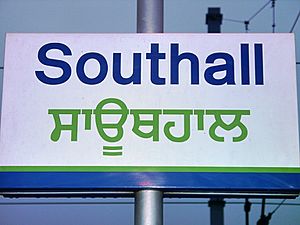
The ḍaṇḍī (।) is used in Gurmukhi to show the end of a sentence. A double ḍaṇḍī, or doḍaṇḍī (॥), marks the end of a verse in poetry.
The visarga symbol (ਃ U+0A03) is used very rarely. It can show an abbreviation, like a period in English. However, modern Gurmukhi uses Western punctuation marks like commas, periods, and exclamation points.
Numbers in Gurmukhi
| Numeral systems by culture | |
|---|---|
| Hindu–Arabic numerals | |
| Western Arabic Eastern Arabic Khmer |
Indian family Brahmi Thai |
| East Asian numerals | |
| Chinese Suzhou Counting rods |
Japanese Korean |
| Alphabetic numerals | |
| Abjad Armenian Cyrillic Ge'ez |
Hebrew Greek (Ionian) Āryabhaṭa |
| Other systems | |
| Attic Babylonian Egyptian Etruscan |
Mayan Roman Urnfield |
| List of numeral system topics | |
| Positional systems by base | |
| Decimal (10) | |
| 2, 4, 8, 16, 32, 64 | |
| 1, 3, 9, 12, 20, 24, 30, 36, 60, more… | |
Gurmukhi has its own set of numbers. They work just like the numbers we use (Hindu–Arabic system). You'll see them a lot in older texts. Today, people often use the standard Western numbers instead.
| Numeral | ੦ | ੧ | ੨ | ੩ | ੪ | ੫ | ੬ | ੭ | ੮ | ੯ |
|---|---|---|---|---|---|---|---|---|---|---|
| Number | 0 | 1 | 2 | 3 | 4 | 5 | 6 | 7 | 8 | 9 |
| Name | ਸੁੰਨ | ਇੱਕ | ਦੋ | ਤਿੰਨ | ਚਾਰ | ਪੰਜ | ਛੇ | ਸੱਤ | ਅੱਠ | ਨੌਂ |
| Transliteration | sunna | ikka | do | tinna* | cāra | panja | che | satta | aṭṭha | na͠u |
| IPA | [sʊnːᵊ] | [ɪkːᵊ] | [d̪oː] | [t̪ɪnːᵊ] | [t͡ʃaːɾᵊ] | [pənd͡ʒᵊ] | [t͡ʃʰeː] | [sət̪ːᵊ] | [əʈːʰᵊ] | [nɔ̃:] |
*In some Punjabi dialects, the word for three is ਤ੍ਰੈ trai (IPA: [t̪ɾɛː]).
Other Symbols
The symbol ੴ is very important in Sikhism. It is made from the Gurmukhi number ੧ ("1") and ਉੰ ("on"). It stands for the Sikh phrase Ik Onkar (ਇੱਕ ਓਅੰਕਾਰ), which means "One God."
How Words are Spaced
Before the 1970s, Gurbani and other Sikh scriptures were written in a style called larivār. This meant there were no spaces between words. Sometimes, a dot was used to separate words, like by Guru Arjan.
Today, Gurmukhi is usually written in pad ched. This means words are separated by spaces.
Here's the first line of the Guru Granth Sahib, the Mul Mantar, in both styles:
Laṛivār: ੴਸਤਿਨਾਮੁਕਰਤਾਪੁਰਖੁਨਿਰਭਉਨਿਰਵੈਰੁਅਕਾਲਮੂਰਤਿਅਜੂਨੀਸੈਭੰਗੁਰਪ੍ਰਸਾਦਿ॥
Pad ched: ੴ ਸਤਿ ਨਾਮੁ ਕਰਤਾ ਪੁਰਖੁ ਨਿਰਭਉ ਨਿਰਵੈਰੁ ਅਕਾਲ ਮੂਰਤਿ ਅਜੂਨੀ ਸੈਭੰ ਗੁਰ ਪ੍ਰਸਾਦਿ ॥
Transliteration: Ik-ōaṅkār sati nāmu karatā purakhu nirbhau nirvairu akāl mūrati ajūnī saibhañ gur prasādi.
Gurmukhi in the Digital World
Gurmukhi on Computers
The Gurmukhi script was added to the Unicode Standard in 1991. This means computers can understand and show Gurmukhi characters correctly.
Some websites still use old fonts that change Latin letters into Gurmukhi. But Unicode makes it much easier to use Gurmukhi online.
The special code range for Gurmukhi in Unicode is U+0A00–U+0A7F.
| Gurmukhi[1][2] Official Unicode Consortium code chart: https://www.unicode.org/charts/PDF/U0A00.pdf (PDF) |
||||||||||||||||
| 0 | 1 | 2 | 3 | 4 | 5 | 6 | 7 | 8 | 9 | A | B | C | D | E | F | |
| U+0A0x | ਁ | ਂ | ਃ | ਅ | ਆ | ਇ | ਈ | ਉ | ਊ | ਏ | ||||||
| U+0A1x | ਐ | ਓ | ਔ | ਕ | ਖ | ਗ | ਘ | ਙ | ਚ | ਛ | ਜ | ਝ | ਞ | ਟ | ||
| U+0A2x | ਠ | ਡ | ਢ | ਣ | ਤ | ਥ | ਦ | ਧ | ਨ | ਪ | ਫ | ਬ | ਭ | ਮ | ਯ | |
| U+0A3x | ਰ | ਲ | ਲ਼ | ਵ | ਸ਼ | ਸ | ਹ | ਼ | ਾ | ਿ | ||||||
| U+0A4x | ੀ | ੁ | ੂ | ੇ | ੈ | ੋ | ੌ | ੍ | ||||||||
| U+0A5x | ੑ | ਖ਼ | ਗ਼ | ਜ਼ | ੜ | ਫ਼ | ||||||||||
| U+0A6x | ੦ | ੧ | ੨ | ੩ | ੪ | ੫ | ੬ | ੭ | ੮ | ੯ | ||||||
| U+0A7x | ੰ | ੱ | ੲ | ੳ | ੴ | ੵ | ੶ | |||||||||
| Notes | ||||||||||||||||
Digitizing Old Gurmukhi Books
The Panjab Digital Library is working to digitize all available Gurmukhi manuscripts. Gurmukhi has been used since the 1500s. Many old writings from that time can still be found. The Panjab Digital Library has digitized over 45 million pages. Most of these are available to view online.
Gurmukhi Internet Names
Punjabi University Patiala has created rules for using Gurmukhi in internet domain names. This means websites can have names written in Gurmukhi script.
See also
 In Spanish: Gurmují para niños
In Spanish: Gurmují para niños
- Punjabi Braille
- Shahmukhi alphabet


